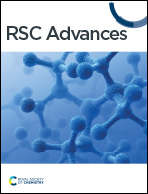High conductivity characteristics of phosphorus-doped nanocrystalline silicon thin films by KrF pulsed excimer laser irradiation method
Abstract
The microstructure and high conductivity properties of phosphorus-doped nanocrystalline silicon films were investigated on samples prepared by a plasma-enhanced chemical vapor deposition technique and the KrF pulsed excimer laser irradiation method. The results of Fourier transform infrared spectroscopy and Raman spectroscopy show that Si nanocrystallites with an average diameter of 2 nm to 3 nm are formed in the film. The degree of crystallinity increases with the increase of laser radiation intensity, while the content of hydrogen decreases gradually. More phosphorus atoms are substitutionally incorporated into the nc-Si dots under higher laser irradiation fluence, which is responsible for the high dark conductivity. By controlling the laser fluence at 1.0 J cm−2, the dark conductivity as high as 25.7 S cm−1 can be obtained. Based on the measurements of temperature-dependent conductivity, the carrier transport processes are discussed. The phosphorus doping and the increase of electron concentration are considered to be the reason for high dark conductivity and extremely low conductivity activation energy.



 Please wait while we load your content...
Please wait while we load your content...